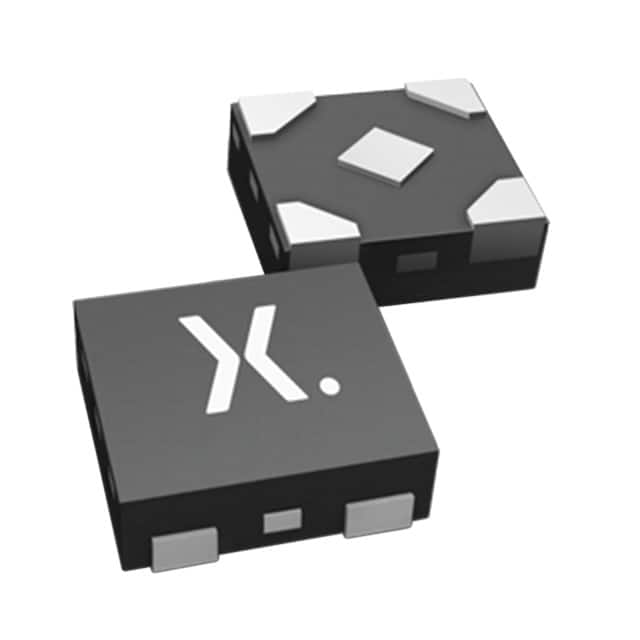74LV1T86GXH
Basic Information Overview
- Category: Integrated Circuit (IC)
- Use: Logic Gate
- Characteristics: Single 2-input XOR gate
- Package: SOT353 (SC-88A)
- Essence: High-speed CMOS technology
- Packaging/Quantity: Tape and Reel, 3000 pieces per reel
Specifications
- Supply Voltage Range: 1.65V to 5.5V
- Input Voltage Range: -0.5V to VCC + 0.5V
- Output Voltage Range: -0.5V to VCC + 0.5V
- Operating Temperature Range: -40°C to +125°C
- Propagation Delay: 4.3ns (typical) at 3.3V supply voltage
Detailed Pin Configuration
The 74LV1T86GXH has a total of 5 pins: 1. GND (Ground) 2. A (Input A) 3. B (Input B) 4. Y (Output) 5. VCC (Supply Voltage)
Functional Features
- High-speed operation: The 74LV1T86GXH is designed using high-speed CMOS technology, allowing for fast logic operations.
- Low power consumption: This IC operates efficiently with low power requirements, making it suitable for battery-powered devices.
- Wide supply voltage range: It can operate within a wide range of supply voltages, providing flexibility in various applications.
- Schmitt-trigger input: The inputs are equipped with Schmitt-trigger characteristics, ensuring reliable switching even in the presence of noise.
Advantages and Disadvantages
Advantages: - Fast propagation delay enables quick response times in digital circuits. - Low power consumption prolongs battery life in portable devices. - Wide supply voltage range allows compatibility with different systems. - Schmitt-trigger input ensures reliable operation in noisy environments.
Disadvantages: - Limited to a single 2-input XOR gate, limiting its functionality compared to more complex logic gates. - SOT353 package may require specialized equipment for soldering and handling.
Working Principles
The 74LV1T86GXH is based on CMOS technology, which utilizes complementary pairs of MOS transistors to perform logical operations. In this case, it implements a 2-input XOR gate, which produces a high output when the number of high inputs is odd. The internal circuitry of the IC ensures efficient and reliable operation within the specified voltage and temperature ranges.
Detailed Application Field Plans
The 74LV1T86GXH can be used in various applications where XOR logic is required. Some potential application fields include: - Data encryption and decryption systems - Error detection and correction circuits - Digital communication systems - Arithmetic and mathematical operations - Control and automation systems
Detailed and Complete Alternative Models
- 74LVX86: Quad 2-input XOR gate
- 74HC86: Quad 2-input XOR gate with higher speed and lower power consumption
- 74HCT86: Quad 2-input XOR gate with Schmitt-trigger inputs for improved noise immunity
Note: These alternative models provide similar functionality but may have different specifications and package options.
This entry provides an overview of the 74LV1T86GXH, including its basic information, specifications, pin configuration, functional features, advantages and disadvantages, working principles, application field plans, and alternative models.
Senaraikan 10 soalan dan jawapan biasa yang berkaitan dengan aplikasi 74LV1T86GXH dalam penyelesaian teknikal
Sure! Here are 10 common questions and answers related to the application of 74LV1T86GXH in technical solutions:
Q1: What is the 74LV1T86GXH? A1: The 74LV1T86GXH is a single 2-input XOR gate with Schmitt-trigger inputs. It is a logic gate integrated circuit that can be used in various digital applications.
Q2: What is the operating voltage range of the 74LV1T86GXH? A2: The 74LV1T86GXH operates within a voltage range of 1.65V to 5.5V.
Q3: What is the maximum output current of the 74LV1T86GXH? A3: The 74LV1T86GXH has a maximum output current of 32mA.
Q4: Can the 74LV1T86GXH be used in both CMOS and TTL logic systems? A4: Yes, the 74LV1T86GXH is compatible with both CMOS and TTL logic systems.
Q5: What is the propagation delay of the 74LV1T86GXH? A5: The propagation delay of the 74LV1T86GXH is typically around 6ns.
Q6: Can the 74LV1T86GXH be used for level shifting applications? A6: Yes, the 74LV1T86GXH can be used for level shifting between different voltage domains.
Q7: Does the 74LV1T86GXH have built-in ESD protection? A7: Yes, the 74LV1T86GXH has built-in ESD protection to safeguard against electrostatic discharge.
Q8: What is the package type of the 74LV1T86GXH? A8: The 74LV1T86GXH is available in various package types, such as SOT353 and XSON6.
Q9: Can the 74LV1T86GXH be used in battery-powered applications? A9: Yes, the 74LV1T86GXH can be used in battery-powered applications due to its low power consumption.
Q10: Are there any recommended application circuits for the 74LV1T86GXH? A10: Yes, the datasheet of the 74LV1T86GXH provides several recommended application circuits that showcase its usage in different scenarios.
Please note that these answers are general and may vary depending on the specific requirements and use cases. It is always recommended to refer to the datasheet and consult with technical experts for accurate information.


